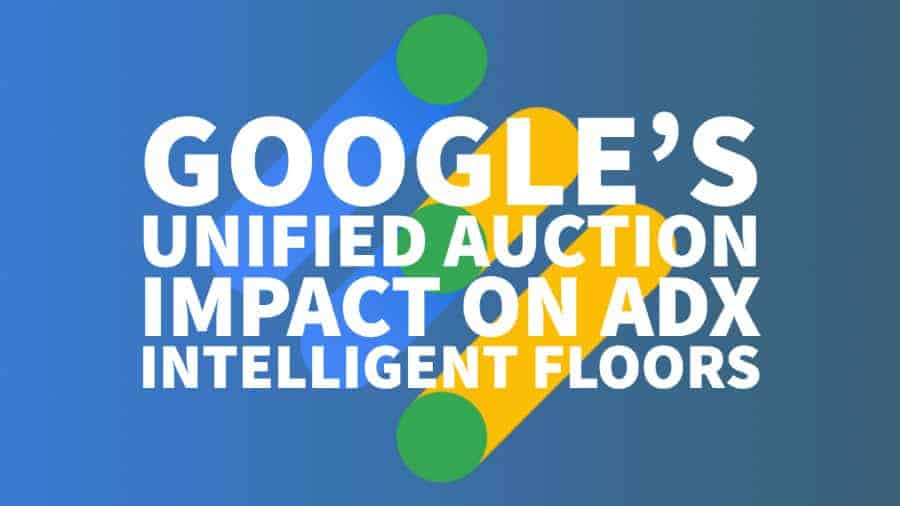
This post was most recently updated on July 11th, 2019
Publishers need Intelligent Ad Exchange Floors more than ever. Early in 2019, Google announced that it would be switching from second price to first price or unified auctions.
With this change in auction dynamics, the consensus is that first price auction buyers will pay what they bid and that price floors will become even more important for publishers. In this post, we’ll show you why publishers like you need a machine learning price floor strategy to protect yourself against advertiser bid shading algorithms.
We wrote a piece covering the big change coming to Google Ad Manager’s auction dynamics in our article – How to navigate Google’s switch from second to first-price auctions as a publisher. We’ve provided a quick summary of the article below:

Google has decided to switch from a second price auction to a first price auction. In June 2019, they will transition all publisher ad inventory to the new auction model and replace open auction rules with unified auction rules.
Unified auction rules make it easier for publishers to manage ad inventory pricing across all demand sources through Google Ad Manager.

Google has been telling publishers that this will simplify their price flooring strategy. But that can’t be further from the truth. Google is giving out its Bid Shading solution to advertisers for free until Jan 2020. Bid Shading solutions like Google’s tinker with the price going into the auction to help advertisers hide the true rate they’re willing to pay. This is a downward bluff. If their rate is lowered too much they don’t get the impression. If it is left alone, they give away their true rate they’re willing to pay.
We’ve covered the importance of pricing floors and machine learning optimization extensively in our article here, “Ad Exchange price floors explained and optimization tips.”
Marketplace dynamics are more important than ever, and publishers need to adopt a machine learning flooring strategy to combat advertiser bid shading that is just as sophisticated. DSPs are arming advertisers with this bid shading technology to help them bid less for your inventory and hide the true rate which the bidder is willing to pay. Sure there is a risk that the advertiser might not win the impression, but that’s all part of the statistical bidding model. In the grand scheme of the transaction landscape, bid shading is just a buyer’s bluff.
We can confirm that dynamic price floor optimization is still useful for first price bidding but now it’s much harder to set it manually in GAM. MonetizeMore’s Intelligent Floor technology analyzes the same bid history and helps you push up the price floor to find the optimal pricing equilibrium faster, and automatically change it over time as bid landscapes change, especially going into Q4.
We have seen other exchanges adjust to first price bidding, and our dynamic price floors adjust to a new optimal equilibrium. As a result, we bring in higher RPMs for publishers.
You have to keep in mind that the ad tech marketplace is like any marketplace and consists of an exchange of trillions of negotiations between the supply and demand of ad impressions. Advertisers want the lowest prices, and publishers want the highest prices.
If they can’t get enough volume for a particular bid because of a price floor set by the publisher, they will increase their bid if their ROI is strong enough. The key is to find that optimal equilibrium of a price floor that is not too high and not too low.
If a publisher chooses to go with no price floors, then they have the equivalent of $0.00 price floors for all bids, which is too low 99%+ of the time. In this case, the publisher would be leaving substantial revenue on the table. Price floors are the publisher’s counter to bid shading, and not using a bid flooring strategy is like sitting down at a poker table knowing everyone else is bluffing, but telling them you’ll never bluff. Turning off floors gives the other players a ridiculous advantage in the transaction landscape. Publishers should not give away this advantage.
As you can see, price floors are as crucial as ever. If you decide not to go with price floors, you would essentially be lowering your RPMs and leaving money on the table. However, having the right price floor strategy is not simple. You need access to technology that finds the perfect price equilibrium for you as manually adapting price floors in an optimal manner has become next to impossible in Google’s move to Unified Auctions.

Kean Graham is the CEO and founder of MonetizeMore & a pioneer in the Adtech Industry. He is the resident expert in Ad Optimization, covering areas like Adsense Optimization,GAM Management, and third-party ad network partnerships. Kean believes in the supremacy of direct publisher deals and holistic optimization as keys to effective and consistent ad revenue increases.

Paid to Publishers
Ad Requests Monthly
Happy Publishers



10X your ad revenue with our award-winning solutions.